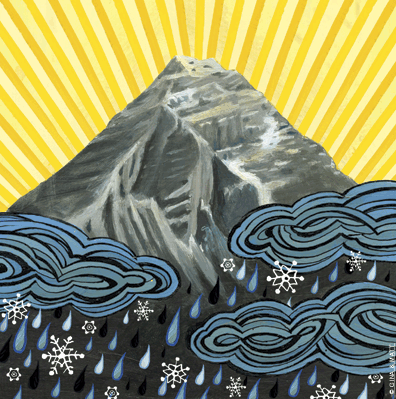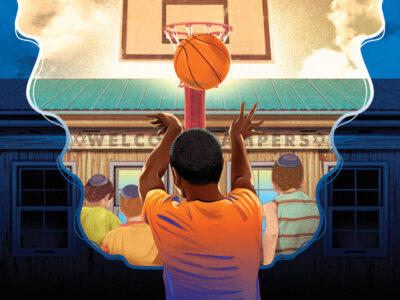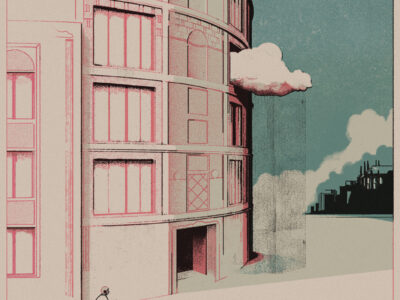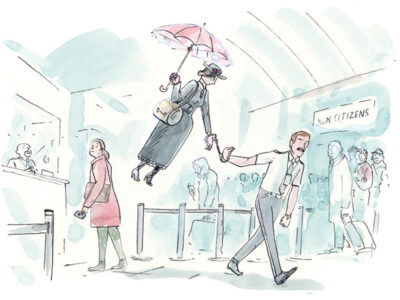
Practicing the “art of happiness” on a trek in the Himalayas.
By Jerome D. Levin | As alluring as Everest was and is, we almost didn’t go—and, I have to admit, there were times along the way when I almost wished we hadn’t.
When we landed, Nepal was on the verge of civil war and Katmandu the scene of daily clashes between police and protestors. Emptied by a strict curfew, the city’s streets were deserted and its stores shuttered. We stayed as close as possible to the airport and felt, if not endangered, depressed by the gloom of the city and its downcast inhabitants. We flew out of Katmandu without having explored it on an 18-seater the next morning. The plane cut between mountains that seemed as if you could touch them and plunged, stomach flippingly, down air pockets before landing in Lukla (which means sheep pasture) on a short strip ending in something like a runaway truck ramp. We disembarked, loaded our dzos—cow-yak hybrids used as pack animals—and started walking.
Things didn’t exactly look up after that, either, at least not at first. After walking through one solid day of rain, which started about an hour after we left Lukla, followed by 40 hours of driving snow as we twisted up and down precipitous trails overlooking thousand-foot gorges, criss-crossed by narrow, swaying suspension bridges, set vibrating by yak trains, we found ourselves sitting around a cold stove, shivering in a dank lodge at over 14,000 feet in Dingbouche. We were far above the tree line, so a wood fire was out of the question. This tiny Himalayan village, now somewhat enlarged by tea houses and lodges catering to Everest trekkers, seemed the incarnation of the dismal. Dingbouche was icy, muddy, populated more by crows and dzos than by people, and getting colder by the second. The thought of spending the night that cold was terrifying us when—almost miraculously, it seemed—our luck changed.
A maiden entered the dining room of our lodge with an armful of yak dung and a jar of kerosene to start it burning. Before long the stove blazed and we relaxed. Yak dung not only burns hot, at lower altitudes it saves the forest and at the higher ones it makes trekking tolerable. So ecologically sound, available, inexpensive, and vital, I offer yaks and their hybrid relatives who carried our gear, and provided cheese and fuel, my unstinting praise. To yaks and all they produce, I say, “Three Cheers!”
(My niece and traveling companion, Ariel, more pragmatic and anticipating the evening repast, asked, “Do you wash your hands before dinner?” as the young woman crammed the stove with the yak dung.)
After a day of acclimating to the altitude, we did some serious climbing and arrived at the last settlement of any size, Lobuche. The steep ascent into Lobuche follows the terminal moraine of the Khumbu Glacier. The moraine consists of rocks, often boulder-sized, which have been pushed down by the movement of the glacier.
By now we were at 16,000 feet, and while we weren’t sick, we weren’t exactly sea-level normal either. The previous day, our guide Sherap had advised a climber/hiker to let his wife take him back down. He wasn’t doing well at all and reluctantly agreed. Later we saw a Japanese man, who looked more dead than alive, being led down on an unwilling horse being pulled by two Sherpas. It made one think—as did the monuments we had passed on the way to Lobuche in memory of trekkers who had died in these mountains.
But such doubts faded as we sank into deep sleep in the lodge at Lobuche. Sherap woke us at 4:00 a.m. to drink “bed tea” before starting the climb to our goal on this trek, Kala Pater (which means Black Rock), the 18,200-foot mountain that faces Everest and the other giant peaks. A kind of bump on the south face of the 26,000-foot Pumori, Kala Pater’s summit was reputed to offer spectacular views of Everest. From there, we would be able to see the summiteers’ tents as well as the Khumbu ice flow where most Everest fatalities occur.
But we weren’t there yet. When we started, at 5:00 a.m., it was bitterly cold. I stopped being able to feel my fingers until I put on another layer of gloves and slowly defrosted them. The water in Ariel’s camelback was frozen solid. My teeth ached from the frigid air each time I inhaled too rapidly in an attempt to stay oxygenated. Every step was treacherous as we constantly struggled to stay on our feet.
I should mention that I had been having major problems with an arthritic left ankle, and I now wore a brace inside my boot. I lived in constant fear that my boot would wet through, as it had during our earlier downpour, and ruin the brace, leaving me to descend on the back of one of those reluctant horses.
Once the sun melted the ice, we were walking uphill through a river, or what felt like one. Finally we reached solid soil and rock. We crested a ridge looking down into the terminal moraine of the Khumbu ice flow coming down from Everest, and at the village of Gorek Shep. Looking upward we could see the glacier-covered faces of Nuptse, Lhotse, and Ama Dablam as well as Kala Pater, dwarfed from this angle by the height of Pumori.
Kala Pater is a deceptive mountain. Because the other peaks are so much higher, it looks easy from a distance. It is also characterized by a series of false summits, making you feel at some points like you will never make it to the top. As we gained altitude we walked back into hard-packed and slippery snow, making me wish that we had crampons. To make matters worse, clouds dominated the sky and we feared getting to the top only to be cheated of a close-up view of Everest.
Then with the suddenness of a curtain rising on a stage, the clouds lifted, revealing Everest in all its majesty and glory. I thought of the City Opera production of Schoenberg’s Moses and Aron in which Moses climbs a hill upon which a curtain rises revealing the Promised Land.
My impatience made me want to run to the top, but of course I couldn’t; we were above 18,000 feet by then. But I got there, turned towards the peaks at the top of the world—Everest, Nuptse, and Lhotse—and started to weep.
When conditions along the way threatened to make reaching Kala Pater impossible, we would experience disappointment and despair until Ariel rallied and said, “Dayeinu,” which means “It would have been enough,” referring to each of God’s miracles on the way to Sinai. In this case it meant that what we had already experienced would have been “enough,” even if nothing further had been possible. And in that “Dayeinu,” our depression lifted and we found the strength to continue.
My pace on the descent was frustratingly slow. The cold and wet had left me with a chest cold that was rapidly turning into bronchitis, my lips were cracked and blistered from the sun, and my “good” right foot was badly swollen. But we made it back.
The Katmandu we returned to was a different city. The King had given in and announced a referendum on the continuation of the monarchy, and you could feel a sense of liberation and joy throughout the city, mirroring our own emotional state as we sat around the hotel pool, awaiting the flight back to New York and a reunion with my beloved wife, Sara.
For a guy with a morbid fear of heights, I hadn’t done badly. I’m not sure how I did it, but I do know that the doing changed something. During the trek I had read The Art of Happiness, by the Dali Lama, and I returned feeling that some of that art had become part of me.
Jerome D. Levin CGS’61 practices psychotherapy in Manhattan and Suffolk County, New York, and teaches at New School University. He last wrote on his mountain-climbing experiences for the Gazette in May/June 2004.




